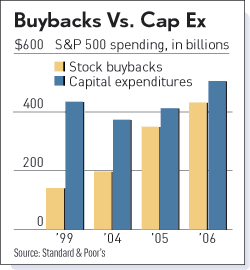Data from Standard & Poor's show that among S&P 500 firms, the yearly amount spent on buybacks has more than tripled this decade. S&P 500 firms spent $432 billion on buybacks in 2006, up 24% from a year earlier.
Meanwhile, annual capital expenditures have risen only 16% since the start of the decade — and actually fell in 2002 and 2003. S&P 500 firms invested $505 billion on global cap spending in 2006, up 23% from 2005. Spending this year has been sluggish, watchers say.
"The cap ex numbers have been pretty weak year to date, and buybacks are still strong," said Alec Young, an S&P equity strategist.
Here's a chart from the same article that shows what's happening here.

According to the Bureau of Economic Analysis, nonresidential investment's seasonally adjusted annual rate for the last 4 quarters was 4.4%, 10.0%, -3.1%, and 2.0%, respectively. In other words, there is a slowdown going on.
So - why would companies use a buyback rather than a capital expenditure?
Here's a simple example. Suppose a company has $100 in earnings and 100 shares outstanding. Their EPS would be $1.00/share. Now suppose there were 50 shares outstanding. The EPS climbs to $2.00 share. In other words, fewer shares = higher EPS and a possible higher stock price.
In addition, the company now has treasury stock to use in buy-outs. Combine increased treasury stock with historically low interest rates and you get an M&A boom.
The article continues:
Many companies get the bulk of their sales growth from overseas. S&P data show that nearly half of the S&P 500's sales last year — excluding telecoms and utilities — came from foreign markets.
But while firms still invest overseas, it's becoming harder to do so.
"The Chinese really aren't hurting for investment capital — it's not like they need investment dollars from XYZ Corp.," van Dijk said. "The Chinese may very well build their own plants. U.S. companies are extremely useful, but not necessarily in terms of writing checks for a plant."
U.S. firms could build plants here, but fewer are doing so because it's cheaper to make goods elsewhere.
Here we get into a discussion of wage/production arbitrage. Simply put, developing countries have lower fixed costs making them more attractive for investment from a company's perspective.
This article brings into light a serious question: how much of recent earnings gains are do to actual increases in revenue and how much of these gains are due to fewer shares? I don't have an answer to that, but I would love to find out.